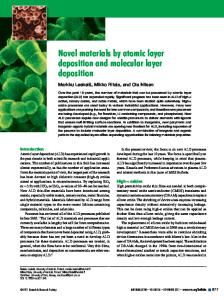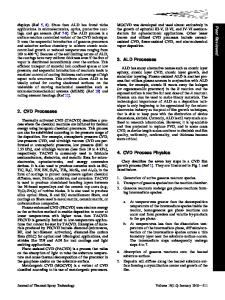Comparison of ZnS-based buffer layers by chemical bath deposition and atomic layer deposition
- PDF / 176,394 Bytes
- 6 Pages / 595 x 842 pts (A4) Page_size
- 68 Downloads / 462 Views
1165-M05-02
Comparison of ZnS-based buffer layers by chemical bath deposition and atomic layer deposition C. Platzer-Björkman1,2* and A. Uhl1 Ångström Solar Center, Uppsala University, P. O. Box 534, SE-751 21 Uppsala, Sweden 2 Institute for Energy Technology (IFE), Avdeling SOL, Pb. 40, NO-2027 Kjeller, Norway *Ph: +47-63806463, Email: [email protected] 1
ABSTRACT In this work we compare ZnS-based buffer layers prepared by atomic layer deposition, ALD, and chemical bath deposition, CBD. Both material and device properties are compared. CBD buffer layers are amorphous with a Zn(OH,S) composition while ALD buffer layers used in devices are crystalline with a Zn(O,OH,S) composition. Devices with ALD buffer layers are stable while for CBD, large lightsoaking effects are seen. Stable devices with CBD buffer layers are obtained by including an ALD-(Zn,Mg)O layer on top of the CBD layer. INTRODUCTION In the search for a replacement of the CdS buffer layer in Cu(In,Ga)Se2 based solar cells, buffers based on ZnS is one of the main options. For this material, several deposition techniques have yielded efficient devices, for example chemical bath deposition, CBD, and atomic layer deposition, ALD. In both cases, the buffers contain large amounts of oxygen in some form. In the case of ALD, we have previously shown that the inclusion of sulfur into ZnO or inclusion of oxygen into ZnS leads to band gap narrowing and that suitable conduction band alignment with CuIn0.7Ga0.3Se2 can be obtained for a ZnO1-xSx layer with x ~ 0.7 close to the CIGS interface [1, 2]. In the case of CBD-ZnS, different compositions have been reported by different groups as for example Zn(S,OH), and Zn(S,O,OH) [3-6] and it is more unclear how the oxygen and hydroxide content influences the junction. In this work we compare material properties of ZnS-based buffer layers by CBD and ALD using mainly photoelectron spectroscopy (XPS) and x-ray diffraction (XRD). We also compare devices made from the same CIGS runs with CBD and ALD buffers. EXPERIMENTAL The CBD-Zn(OH,S) process was established based on previous published results [3-6] within a master thesis project [7]. In that work, bath conditions such as deposition time, concentrations, mixing order and preheating of chemicals were varied in order to establish a buffer deposition process giving efficient devices. In this work, results from materials analysis and device characterization is reported for the most successful CBD-Zn(OH,S) process only. This process uses solutions consisting of zinc sulphate, thiourea and ammonia dissolved in deionized water. The solutions were preheated separately prior to mixing. After all constituents have been poured together in a reactor it was immediately placed in a water bath that was preheated to the reaction temperature. The samples were then immersed in the solution and stirred constantly. After deposition, samples were rinsed in 1.5 M ammonia solution, rinsed by deionized water and blown dry by nitrogen. For better reproducibility a pH and conductivity
Data Loading...











